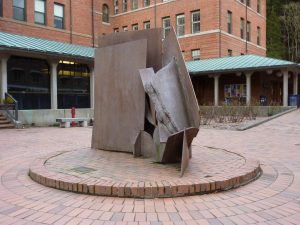ANTHONY CARO
INDIA
1976
Anthony Caro was born in in New Malden, England on March 8, 1924 to a Jewish family of five. When he was three years old, his family moved to a small farm in the country. He went to the prestigious Charterhouse boarding school in his teen years where he began to sculpt with clay. While studying engineering in Christ’s College in Cambridge, he spent his spare time in the studio of sculptor Charles Wheeler, a fellow architecturally-inclined artist. At the tail end of WWII he served two years in the Fleet Air Arm of the British Royal Navy. After his service ended, he committed himself to a life of creating art. Studying art in some of the most prestigious institutions in England, he learned the skills that would earn him award after award. He was married in 1949 to Sheila Girling, a painter. The two would go on to have two sons over the next ten years.1953 marked the beginning of his teaching career at St. Martin’s School for Art in England. His first solo exhibition was in the Galleria del Naviglio in Milan just three years later; this would be the start of a long journey of Anthony Caro’s work being shown in galleries for years to come, continuing up until his death on October 23, 2013. During his lifetime he liked to travel the world and gain inspiration from his travels.
Anthony Caro was primarily an abstract sculptor. His work is characterized by assemblages of metal using “found” industrial objects, primarily sheets of metal. He practiced a modernist style, and much of his art is very simple and focuses on form rather than realism. The sculpture India was created during the years his artistic style transitioned from minimalism to post minimalism (1970’s), however the sculpture can primarily be characterized as minimalist. Most of Caro’s sculptures were indoors and painted bright, bold colors, however for India Caro was satisfied with the placement of it outside to rust over time.
“Making sculpture is a conversation.”
-Anthony Caro
In the 1970’s there was political unrest in India. India’s economy was in poor shape after just ending their war with Pakistan, drought, and the oil crisis of 1973. Opponents of Prime Minister Indira Gandhi saw her increasing power over the Indian government as a threat to democracy. From 1973 to 1975 the conflict against Indira Gandhi’s government became worse to the point of a declaration of state of emergency until 1977. Elections and civil liberties were suspended during that time, and it is said to be one of independent India’s most controversial eras in history.
bibliography
Bradford Sculptures LTD. “Anthony Caro: biography” 2018. http://www.anthonycaro.org/biography
Grimes, William. New York Times. “Anthony Caro, Who Discovered a ‘Path to Abstraction,’ dies at 89.” 2013. ttp://www.nytimes.com/2013/10/25/arts/design/anthony-caro-sculptor-who-discovered-a-path-to-abstraction-dies-at-89.html
Wikipedia. “Anthony Caro.” https://en.wikipedia.org/wiki/Anthony_Caro
Wikipedia. “The Emergency (India).” https://en.wikipedia.org/wiki/The_Emergency_(India)






Leave a Reply